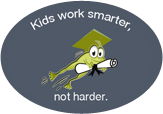![]() Time-blocking is a method of mapping out the most important tasks for your day so you can strategically complete them. If used correctly, time-blocking can drastically increase productivity for students or anyone who is trying to get more work done in less time. But the benefits of time-blocking are not limited to increased productivity. Time-blocking allows you to dedicate more time to things you enjoy. Students who master the habit of time-blocking can expect better grades and less time studying.
Time-blocking is a method of mapping out the most important tasks for your day so you can strategically complete them. If used correctly, time-blocking can drastically increase productivity for students or anyone who is trying to get more work done in less time. But the benefits of time-blocking are not limited to increased productivity. Time-blocking allows you to dedicate more time to things you enjoy. Students who master the habit of time-blocking can expect better grades and less time studying.
What is time-blocking?
Time-blocking is a play on words. In one sense the word block means to carve out a chunk, or block, of time to work on specific tasks. Each block of time should be dedicated to the particular task you plan to work on. The idea is that you estimate the time you need to complete the task, then you focus only on that task during the duration of the time-block. Avoid multitasking or getting side-tracked on anything that is not directly related to your time-blocked task.
The other meaning of the word block is a barrier. Think of your time-block as a barrier to distractions that prevent you from accomplishing your goal. This means the location matters. Location, location, location. Do not attempt to work in an environment that is conducive to distractions. Strategically block them. Each distraction severely sabotages your productivity.
Here is a question: Who is more productive?
John studies for 4 hours in his living room. During that time his mom, dad and kid sister walk through the room 6 times. Each time they ask him something small, such as, “What are you working on,” or “How’s your homework coming along?” His phone is nearby, and he replies to 2 texts and a phone call for 5 minutes. He also gets up to get a snack in the  kitchen once.
kitchen once.
Mike, in contrast to John, studies in his basement office for one hour. He listens to concentration music, and he has no distractions for the entire one-hour time-block.
So who got more done?
John had a total of 10 distractions in his 4 hours of studying. Each distraction can result in 15 to 25 minutes to refocus. That’s backed by considerable science. Assuming 20 minutes for each disruption multiplied by 10 distractions is 200 wasted minutes. That is 3 hours and 20 minutes pretty much wasted because of poor planning by John. That means John’s 4 hours was worth less than Mike’s 1 hour.
Too many middle school students and high school students attempt to study in an environment littered with distractions. Cut them out of your time-blocks and watch how much more you get done in less time.
There are a lot of resources online dedicated to time-blocking. We created a short video to show how you might use Gradeleap along with an online tool called Plan to time-block your homework or studying assignments. You can watch that below.
Students already have a lot of time pre-blocked. Your school days, extracurricular activities, family time, and sleep time are all examples of pre-blocked time. Your time-blocks need to fit around the pre-blocked times or within them.
Fitting time-blocks around pre-blocked times
If you get home from school at 3:30 and dinner is at 6:00 you have 2.5 hours to get something done. You probably need a little time to unwind, but let’s assume you decide you have 2 hours before dinner to dedicate to your schoolwork time-block. You might simply schedule time-blocked assignments from 4:00 pm to 6:00 pm.
Fitting time-blocks within pre-blocked times
You want to avoid multitasking. But that doesn’t mean you cannot do two things at the same time. It only means you cannot do two tasks at the same time. Tasks and things are different. A task is something you need to mentally focus on. You cannot effectively focus on studying for a Math test and writing an English term paper at the same time. However, you can study for the Math test on your ride home from school. That is an example of fitting a time-block within a pre-blocked time. If you can eliminate distractions well enough to study on the ride home, you can make use of that otherwise wasted time.
By creating a visual schedule of expected events and activities in Plan and loading Gradeleap with assignments, you can stay ahead of scheduled assignments so you do not get caught off guard. Large tasks, such as a project or research paper can be broken down into smaller parts that can be completed each day, leading up to a finished product. There is an added benefit, as well. Completing assigned work in a subject each day keeps it fresh in your mind. You slowly add new skills, as you complete the daily assignments. When test time arrives, you are well prepared instead of having to stay up late the night before, cramming for an exam. You’ll simply spend the night before reviewing the main points and getting a good night’s sleep, and you’ll be mentally sharp and alert while taking the test.




